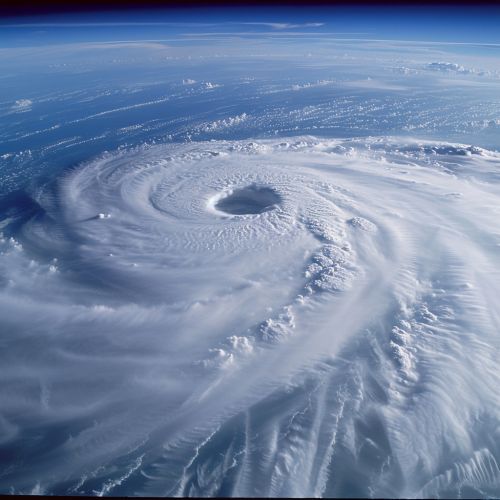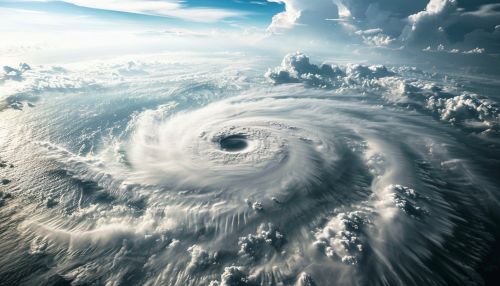Coastal storms
Overview
Coastal storms are meteorological phenomena characterized by severe weather conditions that occur along coastal regions. These storms can include hurricanes, tropical storms, nor'easters, and other types of cyclonic systems that bring strong winds, heavy rainfall, storm surges, and coastal flooding. Coastal storms have significant impacts on both natural environments and human societies, often resulting in extensive damage to infrastructure, ecosystems, and economies.
Types of Coastal Storms
Hurricanes
Hurricanes are intense tropical cyclones that form over warm ocean waters. They are characterized by a well-defined eye, a central region of calm weather surrounded by a ring of strong winds and heavy rain known as the eyewall. Hurricanes can cause catastrophic damage due to their high winds, heavy rainfall, and storm surges. The Saffir-Simpson Hurricane Wind Scale classifies hurricanes into five categories based on their sustained wind speeds, with Category 5 being the most severe.


Tropical Storms
Tropical storms are cyclonic systems with sustained wind speeds ranging from 39 to 73 miles per hour. While less intense than hurricanes, tropical storms can still cause significant damage, particularly through heavy rainfall and flooding. These storms often serve as precursors to hurricanes if they continue to intensify.
Nor'easters
Nor'easters are powerful extratropical cyclones that occur along the East Coast of North America, typically between September and April. They are named for the strong northeasterly winds that blow in from the ocean. Nor'easters can bring heavy snow, rain, and coastal flooding, and are known for their long duration and widespread impact.
Formation and Development
Coastal storms form under specific meteorological conditions. For tropical cyclones like hurricanes and tropical storms, the key ingredients include warm ocean waters (at least 26.5°C), high humidity in the lower to middle levels of the atmosphere, and low vertical wind shear. These conditions allow for the development of a low-pressure system that can intensify into a tropical storm or hurricane.
Nor'easters, on the other hand, form when cold air from the Arctic interacts with warm air from the Gulf Stream. This temperature contrast creates a low-pressure system that can develop into a powerful storm. The presence of a strong jet stream can further enhance the storm's intensity.
Impacts of Coastal Storms
Environmental Impacts
Coastal storms can have profound effects on coastal ecosystems. Storm surges and heavy rainfall can lead to coastal erosion, the loss of habitats, and the introduction of pollutants into marine environments. Mangroves, coral reefs, and wetlands are particularly vulnerable to storm damage.
Economic Impacts
The economic impacts of coastal storms are substantial. Damage to infrastructure, such as roads, bridges, and buildings, can result in billions of dollars in repair costs. The disruption of commercial activities, including tourism and fishing, can also have long-term economic consequences.
Social Impacts
Coastal storms can lead to loss of life, displacement of populations, and long-term psychological effects on affected communities. Emergency response and recovery efforts are critical in mitigating these social impacts.
Mitigation and Adaptation Strategies
Structural Measures
Structural measures to mitigate the impacts of coastal storms include the construction of seawalls, levees, and storm surge barriers. These structures are designed to protect coastal areas from flooding and erosion. Additionally, the reinforcement of buildings and infrastructure to withstand high winds and flooding is crucial.
Non-Structural Measures
Non-structural measures include improved weather forecasting and early warning systems, which provide communities with advance notice of impending storms. Land-use planning and zoning regulations can also reduce vulnerability by restricting development in high-risk areas.
Ecosystem-Based Approaches
Ecosystem-based approaches involve the restoration and preservation of natural barriers, such as mangroves, wetlands, and dunes, which can absorb storm impacts and reduce flooding. These approaches not only protect coastal areas but also provide additional environmental benefits.
Case Studies
Hurricane Katrina (2005)
Hurricane Katrina was one of the most devastating hurricanes in U.S. history. It made landfall in Louisiana and Mississippi, causing widespread destruction and loss of life. The storm surge breached levees in New Orleans, leading to catastrophic flooding. The economic impact was estimated at over $100 billion.
Superstorm Sandy (2012)
Superstorm Sandy was a powerful nor'easter that affected the northeastern United States. It caused extensive coastal flooding, particularly in New York and New Jersey. The storm highlighted the vulnerability of urban coastal areas and led to significant changes in disaster preparedness and response strategies.
Future Trends and Research
Climate change is expected to influence the frequency and intensity of coastal storms. Rising sea levels and increasing ocean temperatures may lead to more powerful hurricanes and more frequent nor'easters. Ongoing research aims to improve our understanding of these trends and develop more effective mitigation and adaptation strategies.
